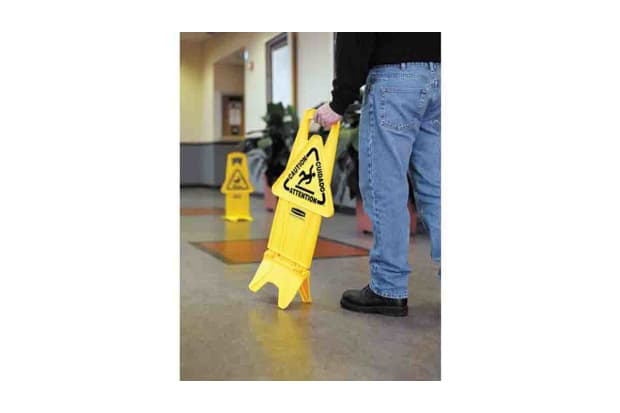- Published 15 Aug 2023
- Last Modified 20 Feb 2024
- 6 min
What are Warning Signs?
Understanding warning signs is crucial to workplace safety. Learn about the colours, shapes, and meanings of these signs based on UK health and safety regulations to make informed decisions for your business.

Warning signs play a pivotal role in promoting safety and preventing accidents in the workplace. These signs are an essential aspect of health and safety regulations, providing relevant information to individuals about potential hazards or risks in an area. Understanding warning signs is not only legally mandated but also a moral responsibility to safeguard employees, clients, and visitors' well-being.
What Colour are Warning Signs?
Warning signs come in distinctive colours to signify the type of hazard or potential danger present. In the UK, three primary colours are used for warning signs:
Yellow
Yellow warning signs indicate general warnings and potential hazards, such as slip and trip risks, electrical hazards, or dangerous substances.
Red
Red warning signs are used to highlight fire-related hazards and issues, such as the location of fire extinguishers, fire exits, or fire assembly points. Additionally, red signs are also used to indicate prohibition, meaning certain actions or activities are not allowed. Prohibition signs may include 'No Smoking', 'No Entry', or 'Do Not Use Mobile Phones', for example.
Blue
Blue warning signs are used to signify mandatory actions or instructions, such as wearing personal protective equipment (PPE) or maintaining a certain level of hygiene.
Green
Green signs are also commonly seen in workplaces. They are typically displayed for indicating safe conditions, first aid facilities, and emergency exits. Warning safety signs featuring green colour may convey messages related to first aid or emergency procedures. For instance, they indicate the location of first aid facilities, such as first aid kits or first aid rooms. These signs are crucial for ensuring that employees and visitors can quickly access medical assistance in case of an emergency. Green signs also identify emergency exits and escape routes, guiding people to safety during evacuations.
Understanding the colours and symbols of warning signs, including those related to warning safety signs and CCTV warnings signs, helps individuals quickly recognise potential hazards. This helps them take necessary precautions and respond appropriately in various situations. It is essential to be familiar with the meaning of each colour and symbol to ensure the safety and well-being of everyone in the workplace.
What Shape are Warning Signs?
The shape of a warning sign is equally significant, as it conveys specific meanings about the potential hazard or action required. In the UK, warning signs come in three shapes:
Triangular Signs
These signs contain a symbol or pictogram within the triangle and signify potential hazards like slippery floors, sharp objects, or falling objects.
Rectangular Signs
Rectangular warning signs are used for general warnings and mandatory actions. They may feature text or symbols.
Circular Signs
Circular warning signs are typically used for fire safety information. They convey instructions about fire exits, fire alarms, or fire equipment.
Warning Signs and What They Mean
Understanding the meaning behind warning signs is crucial. Here are some key types of warning signs and their meanings:
- Hazard warning signs: These signs alert individuals to potential hazards that might cause harm or injury, such as 'Wet Floor' or 'High Voltage'. Displaying hazard warning signs in appropriate areas helps reduce the risk of accidents and injuries
- Safety warning signs: Safety warning signs provide essential information about safe practices and actions individuals should take to avoid accidents. Examples include 'Wear Ear Protection' and 'Keep Emergency Exit Clear'
- Fire warning signs: Fire warning signs are crucial in identifying fire-related equipment and escape routes. These signs include 'Fire Exit', 'Fire Alarm Call Point', and 'Fire Extinguisher'
- Chemical warning signs: In workplaces where hazardous chemicals are present, chemical warning signs are vital to inform individuals about potential dangers and precautions. Examples include 'Corrosive Material' or 'Hazardous Substance Storage Area'
- CCTV warning signs: These signs indicate the presence of surveillance cameras, acting as a deterrent to potential wrongdoers and promoting security in the workplace
Why Choosing the Right Warning Signs is Important

Selecting the appropriate warning signs and displaying them in the necessary places is critical. Here's why it matters:
- Safety and Compliance: Meeting UK health and safety regulations is essential for businesses. Displaying the right warning signs ensures compliance and promotes a safe working environment
- Accident Prevention: Warning signs serve as proactive measures to prevent accidents and injuries. Properly placed, visible signs can mitigate potential hazards, reducing the risk of incidents
- Employee Awareness: When employees are aware of potential risks through warning signs, they are more likely to exercise caution and adhere to safety protocols
- Legal Protection: In the unfortunate event of an accident or injury, having appropriate warning signs can provide legal protection for the business, demonstrating a commitment to safety
- Visitor Safety: Warning signs not only protect employees but also safeguard clients, customers, and visitors who may be unfamiliar with the workplace's potential hazards
FAQs
Summary
Understanding warning signs is crucial for maintaining workplace safety and complying with UK health and safety regulations. The colours and shapes of warning signs convey vital information about potential hazards and actions. By choosing the right warning signs and placing them strategically, businesses can prevent accidents, protect their workforce, and create a safer environment for all. Remember, safety is everyone's responsibility, and warning signs play a fundamental role in promoting and maintaining it.


